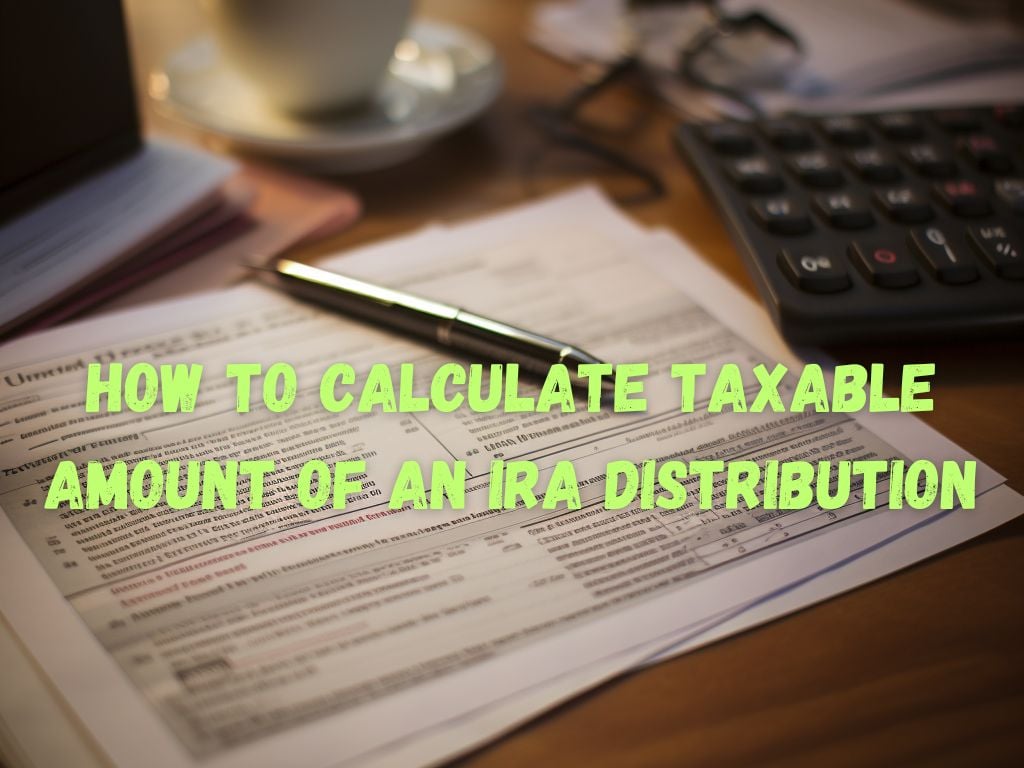An Individual Retirement Account (IRA) is an investment account for retirement, providing tax advantages to those who contribute to it.
A traditional IRA is one where contributions are tax-deductible and investing gains are tax-free until withdrawal, which is taxable as ordinary income.
While the aim of IRA accounts is to ensure that people save for their retirement years, they offer tax benefits to those who contribute, and the distributions from them are taxed when they are withdrawn.
Generating profits from an IRA can be relatively simple. However, the tax implications of these profits can be a bit more complex.
In this article, we will discuss how to calculate taxable amount of an IRA distribution.
Understanding Non-Deductible Contributions
Contributions to a traditional IRA can either be deductible or non-deductible. Deductible contributions reduce taxable income, thus reducing taxable amounts in a given year.
Whereas, non-deductible contributions don’t offer a tax benefit during the contribution phase but avoid double taxation on investment earnings.
Differentiating Deductible and Non-Deductible Contributions
Deductible contributions are contributions that are made using pre-tax income, as a result, reducing taxable income.
Non-deductible contributions, on the other hand, are made with after-tax income, and as a result, they don’t reduce current taxable income in the contribution year.
The IRS allows you to make annual contributions to your IRA account of up to $6,000 if under 50, and $7,000 if you are over 50 years.
For most people, contributions to the traditional IRA are tax-deductible, which means when you file tax returns in the following year, you get the money back that you paid as income taxes on the contribution amount, depending on your tax bracket.

Determining the Portion of Non-Deductible Contributions in your IRA
If you make contributions to your traditional IRA with pre-tax dollars, you lower your taxable income in the year of contribution.
Money in a traditional IRA account then grows tax-free until you withdraw it. It is at the withdrawal point that you pay income taxes on the contributed amount and earnings.
On distributions, withdrawing contributions from the traditional IRA won’t come with tax consequences because you’ve already paid tax on them, it’s the earnings that are taxable as ordinary income at your marginal rate.
If every contribution to your traditional IRA received a tax deduction, all distributions from the IRA would be taxable as ordinary income.
However, when you make a contribution to a traditional IRA and don’t receive a tax deduction due to income constraints, you’ll have to allocate a portion of the nondeductible contribution to the total IRA balance. Let’s take an example:
Suppose John contributes $4,000 to his traditional IRA account in 2023. $3,000 of it is deductible, and $1,000 is non-deductible. By December 31, 2023, his account value is $30,000, consisting of $23,000 deductible contributions, and $7,000 earnings. So, his taxable portion of the value is ($7,000/$30,000) = 23.3%.
Ways to Calculate Taxable Amount Of An IRA Distribution
First, to evaluate the taxable amount, the account holder must find the total value of the distribution received from the IRA.
Once the account holder has calculated the distribution’s value, the next step would be to separate the percentage of the distributed amount that is taxable and nontaxable.
Assessing the Total Value of the IRA Distribution
If you receive a distribution from your IRA, you’ll need to report the total distribution amount on your tax return. The distribution includes not only the amount you withdrew but also any other fees or taxes that might have been deducted.
Determining the Percentage of Taxable and Non-Taxable Funds
Before calculating the taxable portion of your withdrawal, you need to determine the IRS-approved formula for calculating the percentage of your IRA account that is tax-free.
The equation may include previous years’ non-deductible contributions, previous years’ withdrawals, and your current year’s taxes, so it’s important to review IRS Publication 590 to ensure the tax-free portion is calculated correctly.
Considering the Tax Implications of Different IRA Types
It is important to note that there are different types of IRA accounts, such as Traditional IRA, Simplified Employee Pension (SEP) IRA, Salary Reduction Simplified Employee Pension (SARSEP) IRA, and Simple IRA, with varying tax implications.
Traditional IRAs and SEP IRAs work similarly in terms of the tax advantages they provide. Contributions made to these accounts are typically pre-tax, and investment gains are tax-deferred up until distributions are made.
In the year of distribution, the amount of the distribution is taxed at the ordinary income tax rate.
Simple IRAs, as the name implies, have simpler rules. They are designed to be easy to manage for small business owners. They are attractive to small business owners because of the low maintenance costs and contribution limits.
Simple IRAs follow the same taxation rules as Traditional and SEP IRAs, where investment gains are not taxed until withdrawals are made.
SARSEP IRAs are very similar to traditional IRAs, with the main difference being that employers can make contributions on behalf of their employees. They were only available from 1978 to 1996 as a way to help offset the decline of traditional pensions.

Pro Tips and Strategies
Using the Pro-Rata Rule for Multiple IRA Accounts
If a taxpayer has one or more traditional IRA accounts, it is important to know how the pro-rata rule works. The pro-rata rule is used to determine the taxable status of a distribution when a taxpayer has multiple IRA accounts.
Maximizing Deductions to Minimize Taxable Amount
The contribution limit for IRAs in 2023 is $6,500 annually, or $7,500 if 50 or older, which limits your options to reduce the taxable portion of the distribution.
Nevertheless, people over the age of 59 1/2 may contribute more than $6,500. This is known as a “catch-up” contribution, and it allows the older population to save more money for retirement.
Considering Tax Brackets and Distribution Timing
Pre-planning regarding distribution timing and tax management can be helpful in minimizing the taxable amount. Another consideration is the individual tax bracket, which tells the maximum percentage that a taxpayer will have to pay in taxes.
FAQs
How are taxes calculated on IRA withdrawals?
Taxes are calculated on IRA withdrawals as ordinary income tax rates.
Do seniors pay taxes on IRA withdrawals?
Yes, seniors are required to pay the same tax rates upon withdrawing from their IRA accounts.
When do I pay taxes on my IRA withdrawals?
Taxes on IRA withdrawals are due in the year they are withdrawn.
Conclusion
In summary, calculating the taxable amount of an IRA distribution takes some evaluation, but it’s essential to do it correctly to avoid being penalized by the IRS.
Whenever you’re unsure about any tax implications related to your IRA distribution, it is best to seek professional advice.
Nonetheless, by understanding the fundamental rules governing deductible and non-deductible contributions, account owners can accurately compute the taxable portion of their IRA distributions.


 Tags:
Tags:










